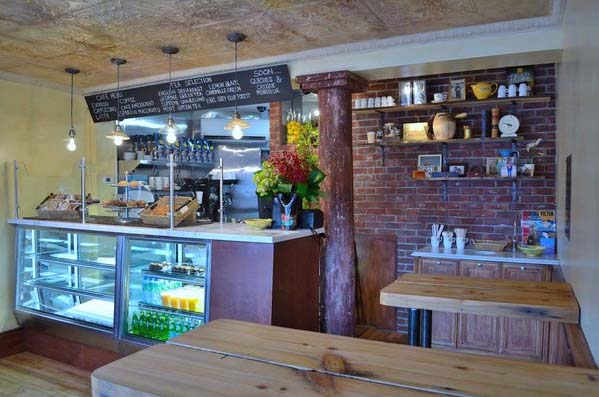 | |||
 | |||

|
Ten reasons why 70 Greenwich Avenue at 11th Street just may have been the primary inspiration for Edward Hopper's Nighthawks Nighthawks by Edward Hopper (painted 1941-1942); collection of Art Institue of Chicago 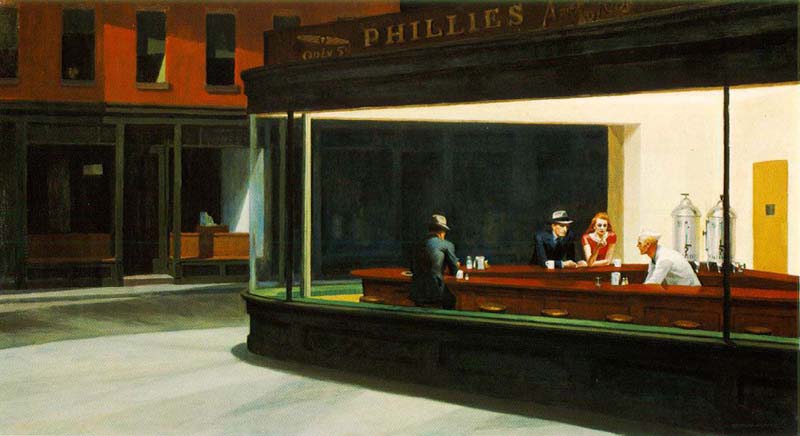
70 Greenwich Avenue ("West Village Florist") at the intersection of West 11th Street, southeast corner, just east of Seventh Avenue. 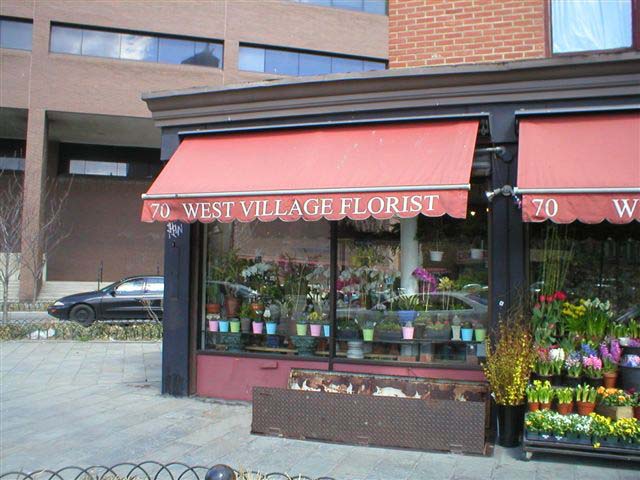
Composite 1: Adding the interior of Nighthawks to the florist store. 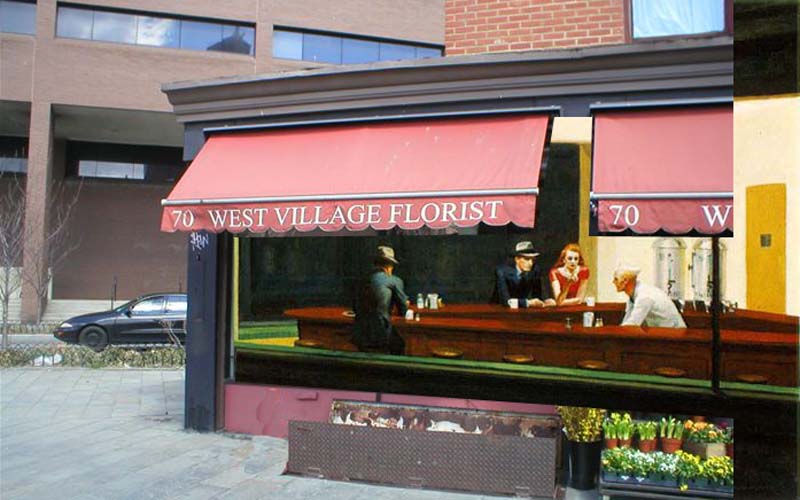
Composite 2: Stripping away some features. 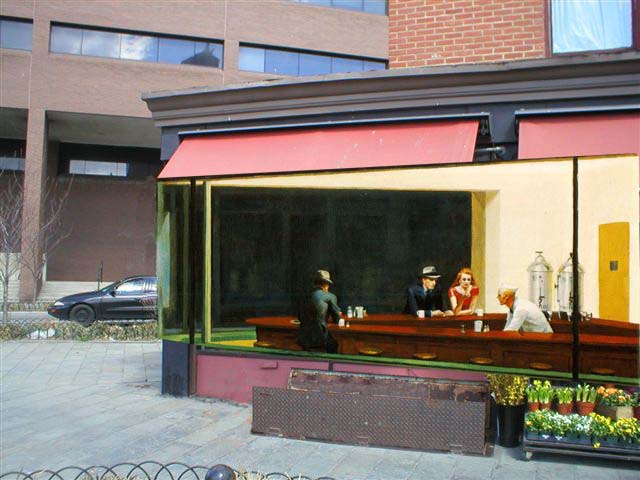
Composite 3: Substituting the Nighthawks cafe for the florist shop. 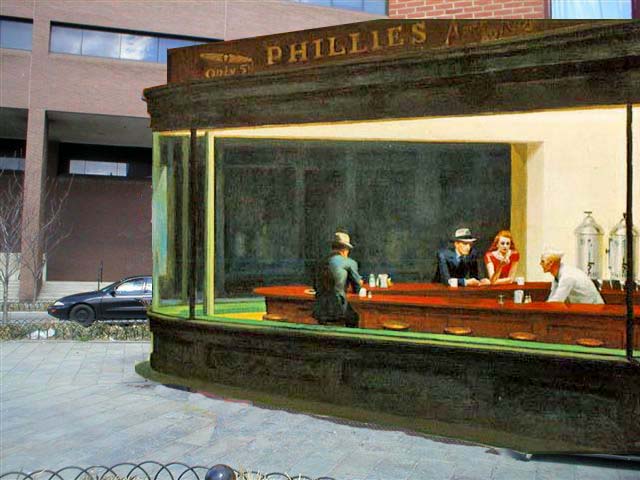
Introduction
Edwards Hopper's 1942 painting Nighthawks is among the most famous and beloved paintings in the world. Three people sit in an all night restaurant in an urban area while being waited on by a man in a white uniform. Who's talking to whom? What are they talking about? How did these people end up in the same brighly lit all night cafe? The painting asks a thousand questions. It's mysterious and moody and endlessly captivating. The PopSpots goal is not to analyze the themes of the painting but to see if I can figure out the angled restaurant space that it was primarily based on, using quotes from Hopper, the process of elimination, and clues in the paintng. I've already shown you a picture of the building I think it was primarily based on. Hopper said the building was on Greenwich Avenue in New York. This is number 70 Greenwich Avenue, currently a florist shop. Let me take you through my analysis, which will start after these three pictures. The album is so famous it has been parodied thousands of times - as these sample results from Google Images show (search for "Nighthawks Parodies") 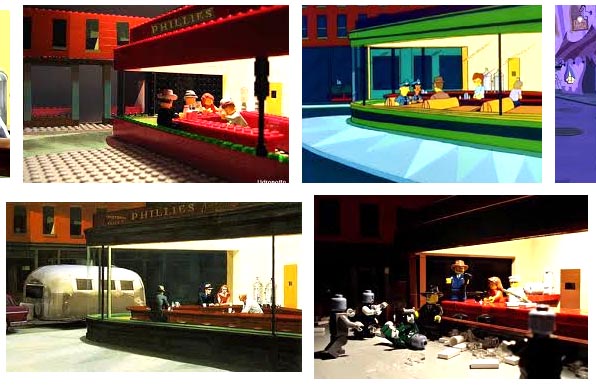
From Google Images It's been referenced in album covers like this from Orchestral Manoeuvres in the Dark. 
And people like me even even make Season's Greetings cards out of it. (That's me serving my family. Looks like I forgot my hat.) 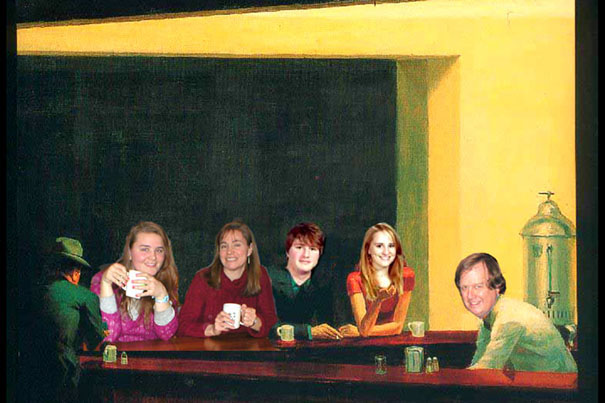
THE FACTS WE KNOW ABOUT THE LOCATION OF NIGHTHAWKS Most of the information known about the possible location of the painting of Nighthawks comes from Hopper's primary biographer (and writer of Hopper's catalogue raisonne) Gail Levin in her biography Edward Hopper: An Intimate Biography. I've divided them into three sets of Quotes:A) Quotes relating to THE EXTERIOR OF NIGHTHAWKS I will be referring to the quotes as we go through the entry. But to save you time, you can skip reading them for now, because the quotes about the location boil down to this (which reads like a Zagat Guide): The setting of Nighthawks was a "lunch counter" / "all-night coffee stand" / "restaurant" on Greenwich Avenue "where two streets meet." And Hopper is quoted as saying "I... made the restaurant bigger." That's it. Scout's honor. That's all we know. Well, that plus what we can see in the painting. So let's take a look. (You can skip the quotes for now and go down to THE 10 REASONS.) A) Quotes relating to THE EXTERIOR OF NIGHTHAWKS 1) "Ed has just finished a fine picture - a lunch counter at night with 3 figures." ...from a letter by Jo Hopper (Hopper's wife) to Marion Hopper: - Gail Levin, Edward Hopper: An Intimate Biography Knopf, 1995, New York paperback, page 349. footnoted to Jo Hopper letter to Marion Hopper, letter of January 22, 1942. 2) ..."{It} was suggested by a restaurant on Greenwich Avenuee where two streets meet." ... a quote attributed to Hopper as quoted in Kuh, Artist's Voice, p. 134. according to Gail Levin, Edward Hopper: An Intimate Biography, Knopf, 1995, New York paperback, page 349. 3) "Another interviewer gathered that the picture was "based partly on an all-night coffee stand Hopper saw on Greenwich Avenue in downtown New New York, "only more so." Gail Levin, Edward Hopper: An Intimate Biography Knopf, 1995, New York paperback, page 349. footnoted to "The America of Edward Hopper," Vogue, 123, June 1954, p. 49. (There is no author listed to Vogue article, just captions to four photos of Hopper's work. The captions read as if the caption writer had interviewed Hopper, so when the writer quotes "only more so" it seems like an emphasis by Hopper. (There is no exact way to determine what "only more so" means, but I read it as meaning something to the extent of "an all-night coffee stand jazzed up for artistic effect." 4) "I simplified the scene a great deal and made the restaurant bigger." a quote by Hopper As found in - Gail Levin's Edward Hopper: An Intimate Biography Knopf, 1995, New York paperback, page 349. The quote is footnoted to Kuh, Artist's Voice, p. 134. B) Quotes relating to THE INTERIOR OF NIGHTHAWKS 1) "To get the (coffee) urns he went to the Dixie Kitchen, a coffeeshop where he and Jo often picked up a cheap meal." Gail Levin, Edward Hopper: An Intimate Biography Knopf, 1995, New York paperback, page 349. footnoted to Jo Hopper diary excerpt for March 24th, 1959. 2) "Hopper may also have found one of the illustrations for the "The Killers" suggestive. C. Leroy Baldridge depicted a counterman by a coffee urn that is almost a mirror image of the detail in Nighthawks. Hopper must have seen both the story and the illustrations a second time after Scribner's reprinted them along with one of his own illustrations in its 50th Annivesary issue of January 19337, 101, pp.83 and 73." -Gail Levin, Edward Hopper: An Intimate Biography Knopf, 19995, New York paperback, page 616 in footnote #9.. C) Quotes relating to THE THEME AND MOOD OF NIGHTHAWKS 1) He (Edward Hopper) "drew on sources" such as popular "gangster movies popular in the 30's; and Ernest Hemingway's "The Killers," a story Hopper liked so much upon reading it in Scribner's for March 1927 that he wrote to the edior..." Gail Levin, Edward Hopper: An Intimate Biography Knopf, 19995, New York paperback, page 350. The Ten Reasons why 70 Greenwich Avenue at 11th Street just may have been the primary inspiration for Edward Hopper's Nighthawks: Reason #1 - Because Hopper said "{It} was suggested by a restaurant on Greenwich Avenuee where two streets meet. This is a map of Greenwich Avenue in Greenwich Village, Manhattan, New York City. I have marked - with red triangles - all the intersections where "two streets meet" at less than a 90-degree angle, which is the popularly acceptred shape of the cafe in Nighthawks. 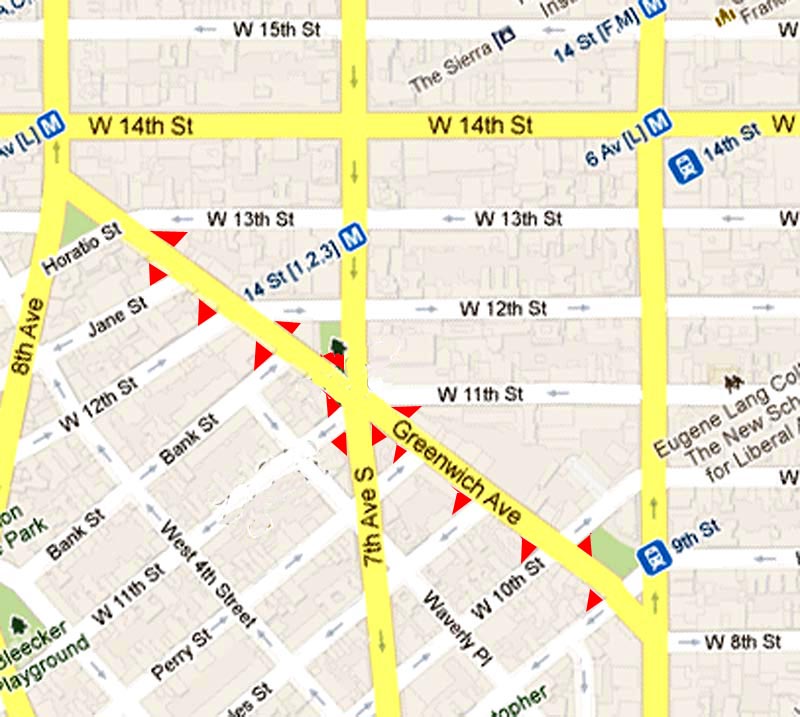
Greenwich Avenue is a "diagonal" street that cuts across Manhattan's roughly North-South avenues and East-West streets. There are many places where two streets come together forming less than a 90-degree angle. The resulting corners are "v" shaped (like a pizza slice), and usually form somewhere between a 30-degree to an 80-degree angle. This wedge-shape formation is what I think most people think Hopper means when he says "where two streets meet." Note that Hopper didn't say "where two streets intersect." Streets usually intersect at 90-degree angles. (via John Davis) The building housing 70 Greenwich Avenue is in the shape of about a 30-degree "V," as is the Nighthawks restaurant. 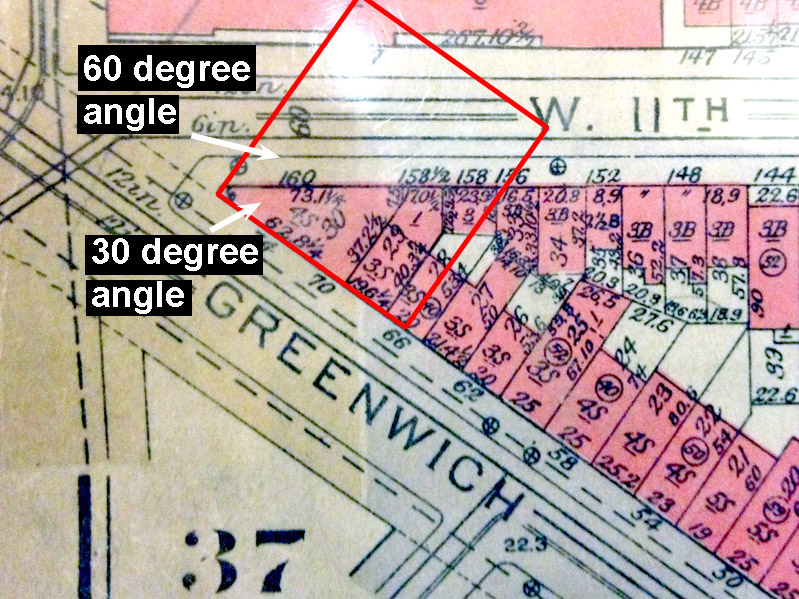
This is a photo of the building housing 70 Greenwich Avenue. The florist shop is on the ground floor. You can see the severe 30-degree angle of the building. 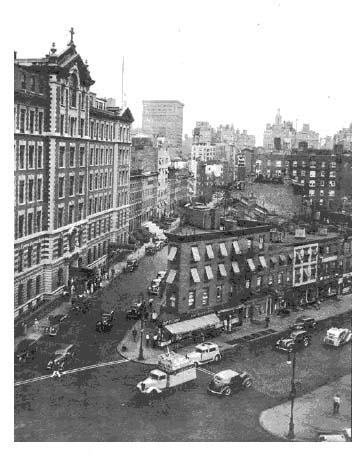
This is looking straight down at that building. The red lines indicate the floorplan of the florist shop. 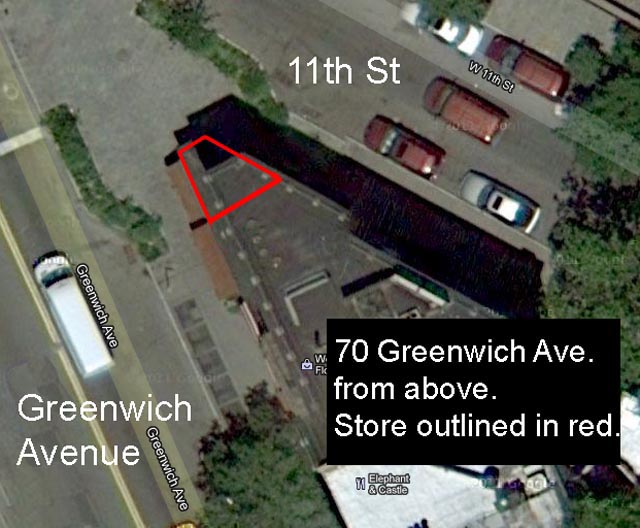
The pointed and triangular shape of the Nighthawks dining counter emphasises the severe angle of the street. Also, the stores in the background seem to get smaller from right to left, indicating a sharper perspective then would come from an angle greater than about 45-degrees. If you click the link below, it will take you to a second page of this website which shows all the stores indicated by the red marks on the map above. These are all stores on Greenwich Avenue on corners that are less than 90-degrees. Thus, they are all theoretically possibilities for being the Nighthawks space. It's very interesting to see how many of them actually look like they could be the setting for Nighthawks. You can go there now, and come back, or just scroll to Reason #2 below, where I have narrowed down some of the best possibilities from that page. Click this to see photos of all the stores on Greenwich Avenue that have less than 90-degrees fronts. Reason #2 - Because #70 Greenwich Avenue is one of the five spaces that are formed at less than a 60-degree angle, as is Nighthawks. It would follow that if Hopper was trying to emphasize the narrow "v" made by two streets intersecting, he would base the painting on a store that an extreme angle. That would mean that he likely based it on one of these five extremely-small-angled stores. Here they are, going from north to south. West 13th and Greenwich Avenue (east side) 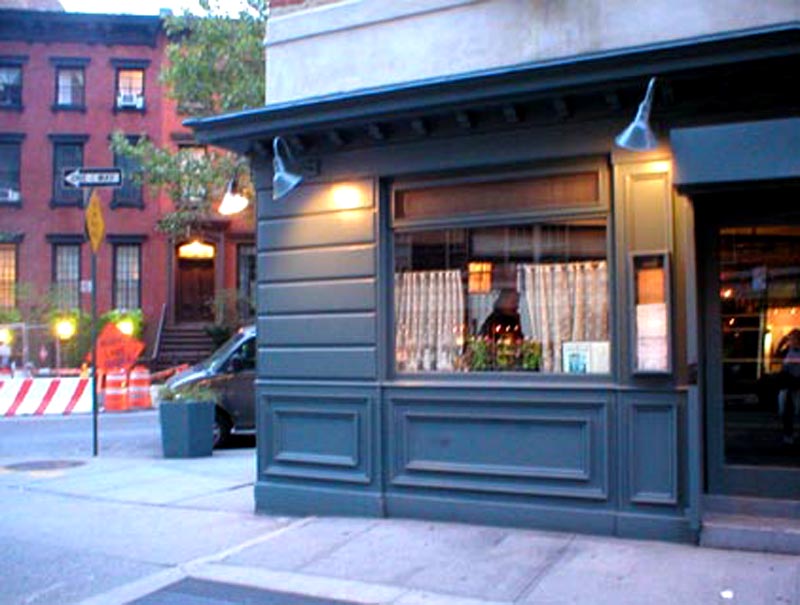
Jane Street and Greenwich Avenue (west side) West 12th and Greenwich Avenue (west side) 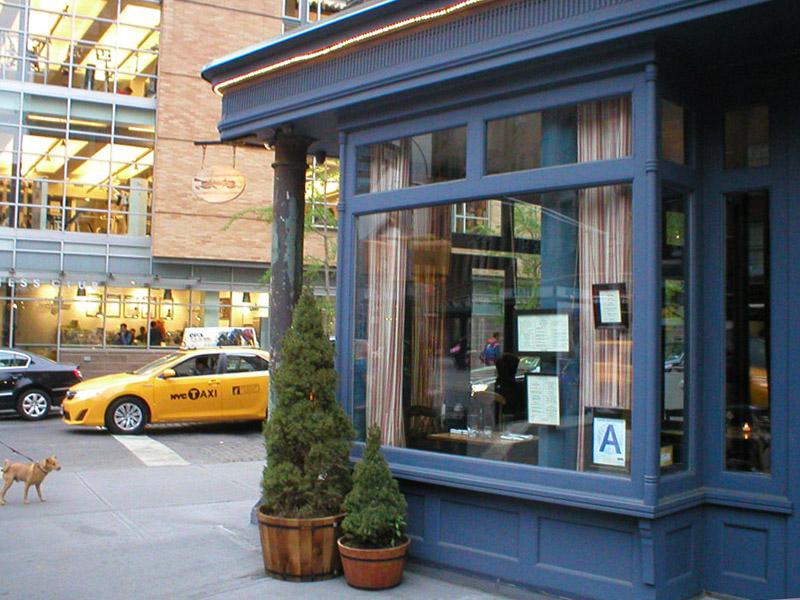
West 12th and Greenwich Avenue (west side) (note: This corner has the angle, but Hopper would have had to invent the whole tip of the restaurant, so I would discount it.) 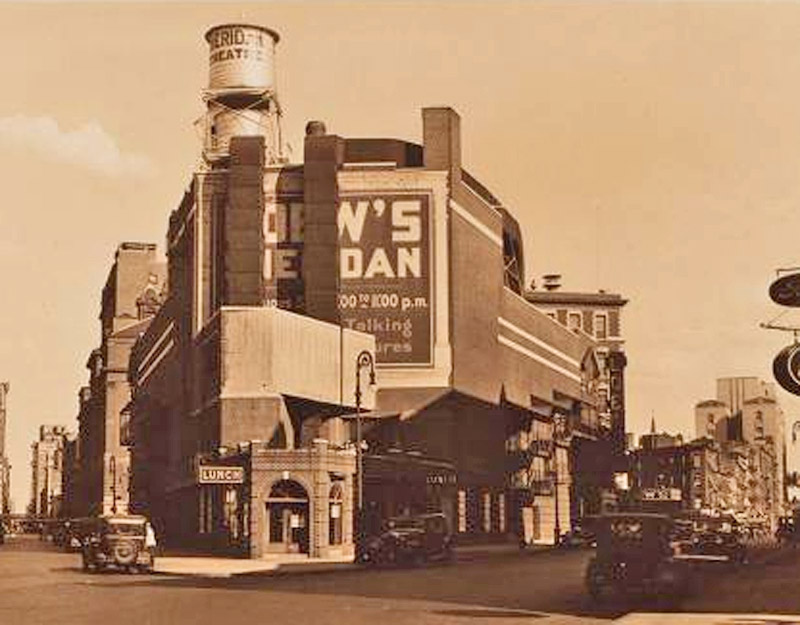
From the NYPL Digital Archives West 11th Street and Greenwich Avenue (70 Greenwich Avenue) (east side) Reason #3 - Because the small black triangle above the Phillies sign in Nighthawks is likely the bricks of the building above, thus making the Nighthawks space a "prow" - an extention of the building. The Nighthawks restaurant sticks out in space like the "prow" or front of a boat. It extends out from the building housing it, like a cowcatcher on a train, or a "prow" of an old pirate ship. A "prow" is "the projecting front part of something such as a car or a building (Wikipedia.). 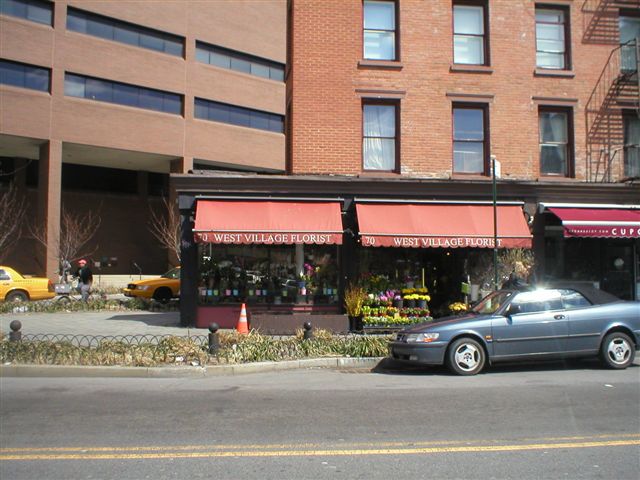
if you look at the photos below, you can see that the buildings across the street behind the restaurant that extend down the block are blocked by something black right above the restaurant (I circled the small triangular black spot above the Phillies sign). I would suggest that this is the side wall of the brick apartment building above the florist shop. 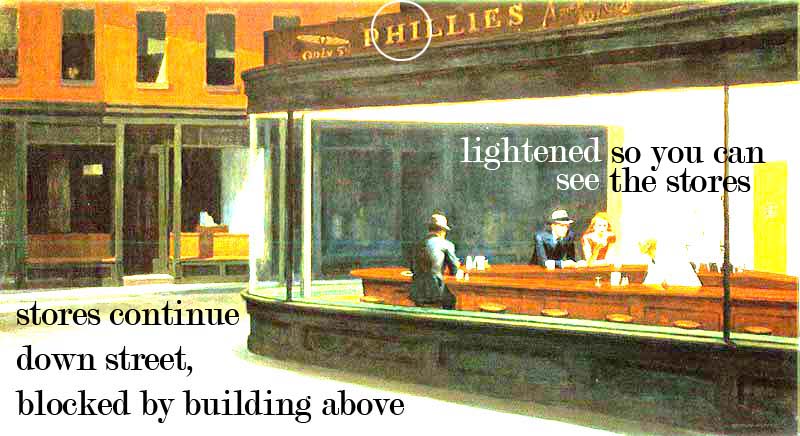

That would make this space a "prow." This is unique among intersecting streets along Greenwich Avenue. There are no other prows presently along the avenue and my old photographs don't indicate one either. In Hopper's day there was a one-story building housing a restaurant at 12th street (you can see some photos of it on the Greenwich Avenue page.), but it was basically a one-story building attached to the back of the movie theater, and not a prow, which usually extends out to the front. There were also one-story buildings at 11th street (west side) and 10th Street, eastside) but they were not prows either, just isolated buildings. This, by itself, would make 70 Greenwich Avenue the prime candiate to be the inspiration for Nighthawks but there's more, so let's continue. But before we do, I want to discuss the "prow" on the Flatiron Building, located about 12 blocks nonrtheast of Greenwich Avenue, and which looks like the Nighthawks diner more than any building Greenwich Avenue, even #70. The Flatiron and its prow were built in 1902 and Hopper would no doubt know it well. In fact, if Hopper hadn't said he that patterened Nighthawks after a restaurant on Greenwich Avenue, I would have thought this was his inspiration. So let's take a look at it, because I'm sure some of the Nighthawks imagry comes from it. (To see it on Google Street Views; go to 175 Fifth Avenue). The prow on the Flatiron. The black shape and rounded glass end could be right out of Nighthawks. And it's definitely a prow. The text in the window of this temporary exhibit even says "prow." Note also the shape of the white table in this exhibit -- it is somewhat similar to the shape of the triangular counter in Nighthawks. The curved glass end - similar to that on Nighthawks 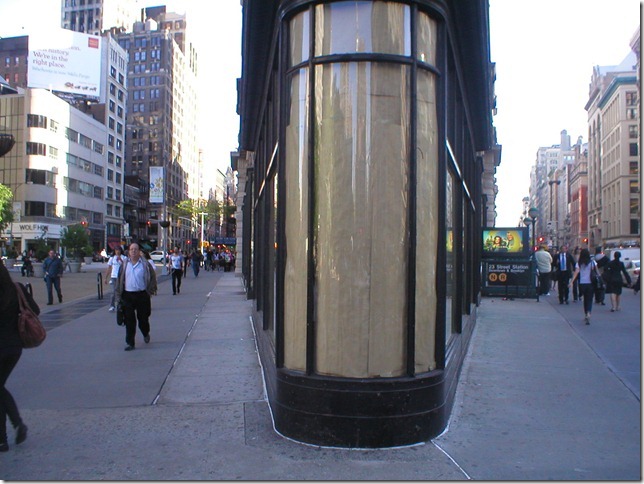
The rounded corner from another angle. The curved glass in Nighthawks has similar black vertical frames. 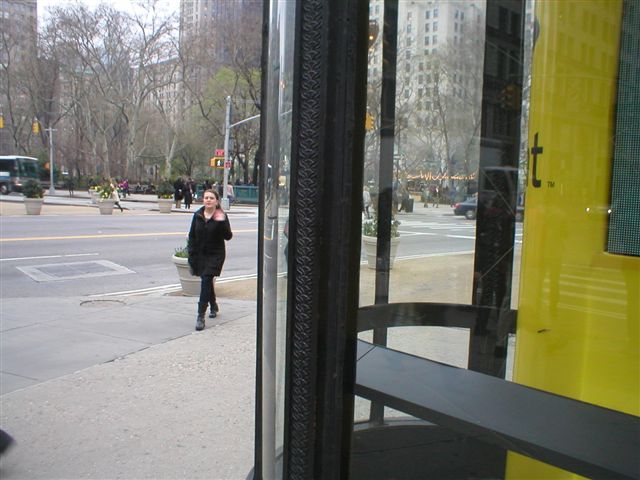
The prow turned into a battleship in a war drive. Notice the sign that says they sold cigars in it, like in Nighthawks That entrance door on the right is no longer there. 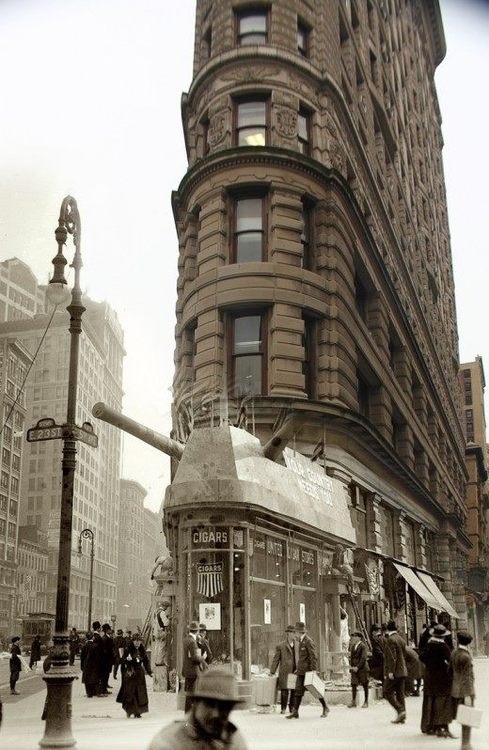
Reason #4 - Because #70 Greenwich Avenue has a history of being a form of restaurant or coffee-shop known as a "fountain." A "fountain restaurant" was short for a restaurant with a soda fountain, which primarily served cola type drinks with carbonated water from a "fountain." A "fountain" might also sell soup and sandwiches and been referred to as a restaurant. 
Thus, when Hopper says "he enlarged the restaurant," 70 Greenwich Avenue fits the bill because it was big enough to have a small counter with a few stools in it, and consequently could be referred to as a restaurant. This photo is of a small diner on Lexington Avenue, New York. These five chairs could easily have fit into what is now the florist shop, making it a "fountain restaurant." Old photos indicate that the space has a history of being a "fountain"- type restaurant - one that has at times served soda (presumably from a "fountain") and sandwiches (which one would eat presumable sitting down. Below are several pictures of the "florist shop space" through the years. In the 70's it said "soda-fountain-sandwich." In the 30's and 40's there was an Optimo cigar sign on it." In 1930 it read "Soda-Cigars-Fruit." And earlier than that it advertised "Murad" cigars. 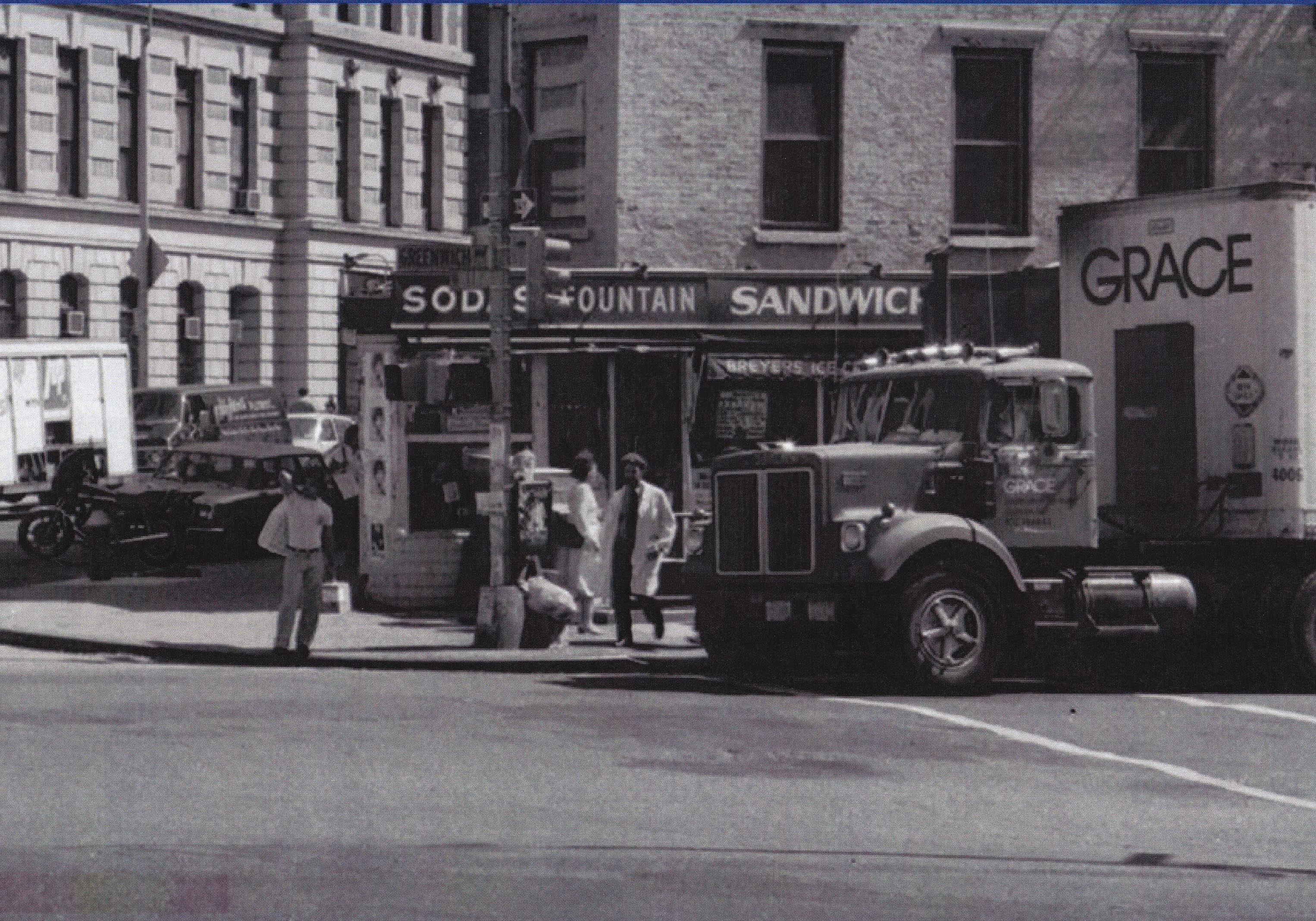
Photo from 1979 - Library of Congress 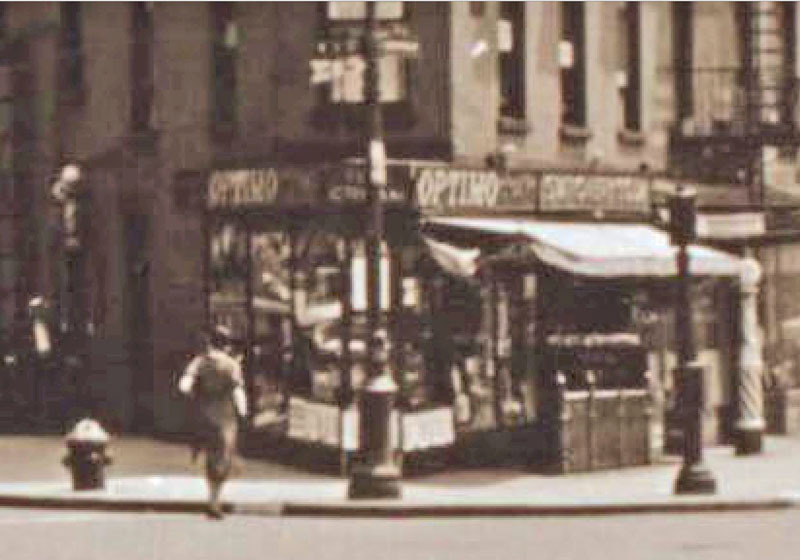
Photo from 1938 - NYPL That's a close-up of this photo. (Click to enlarge) 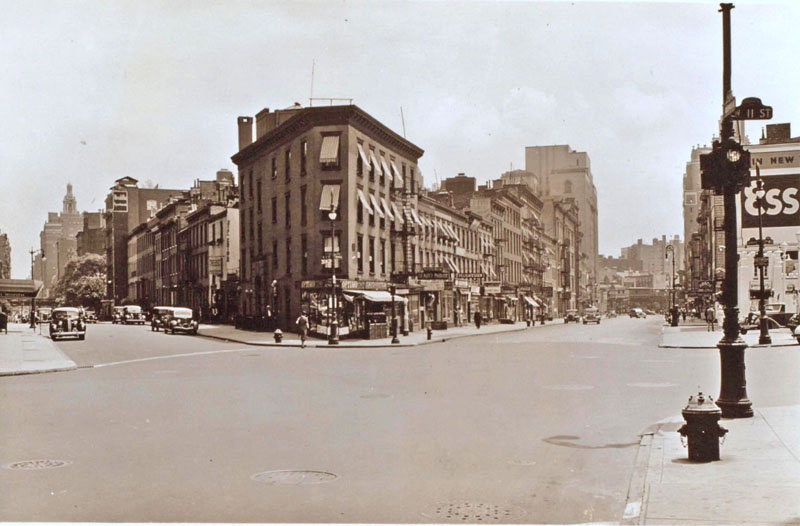
Photo: 1938 - NYPL 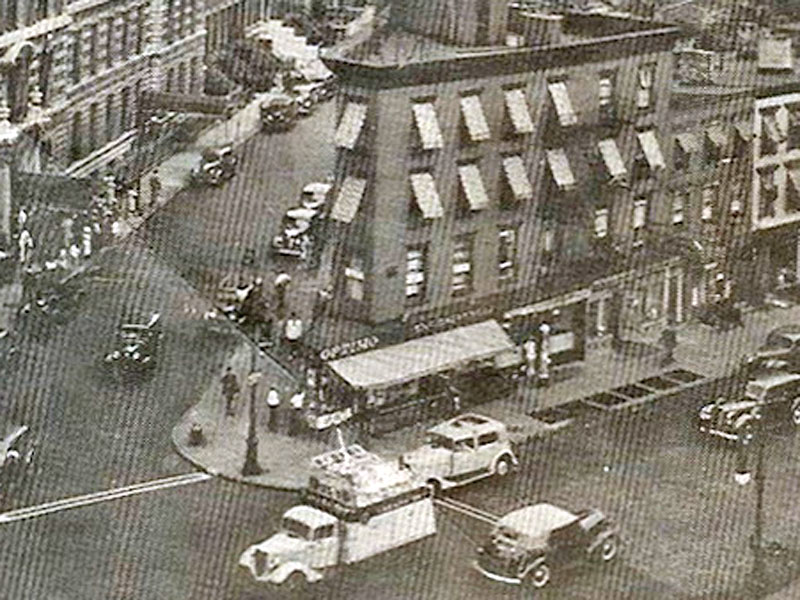
Photo from 1940's 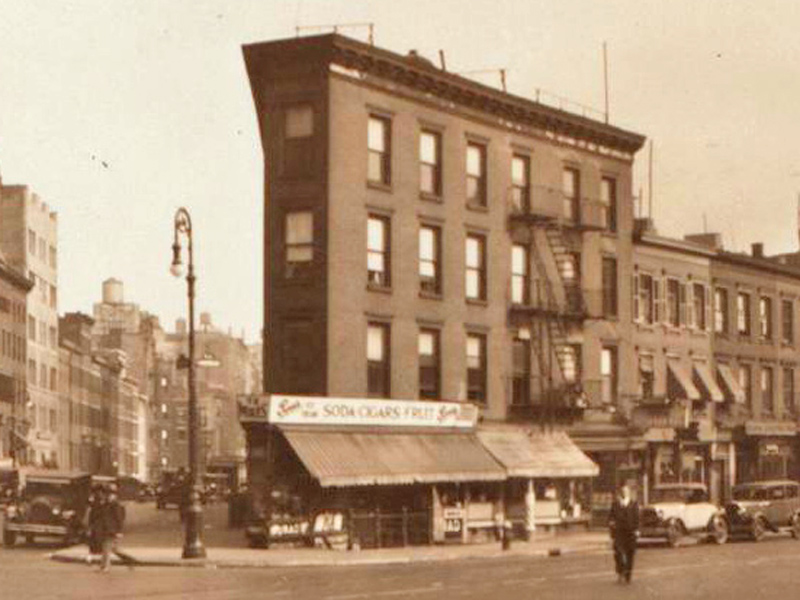
Photo from 1930 - NYPL That's a close-up of this photo. (Click to enlarge) 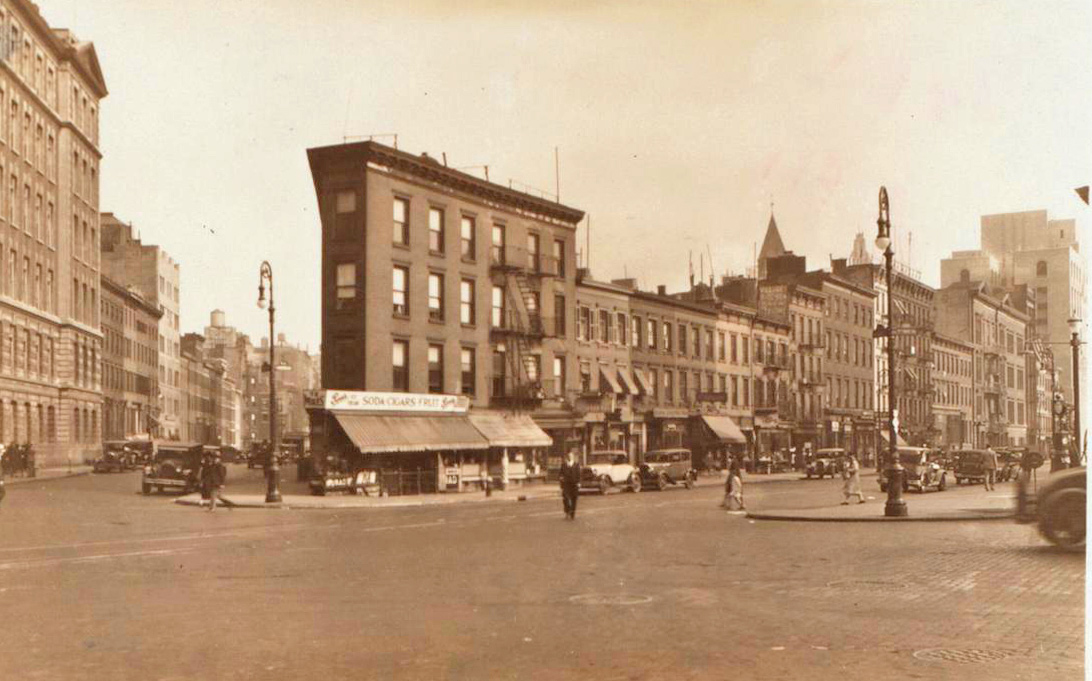
Photo: 1930 - NYPL 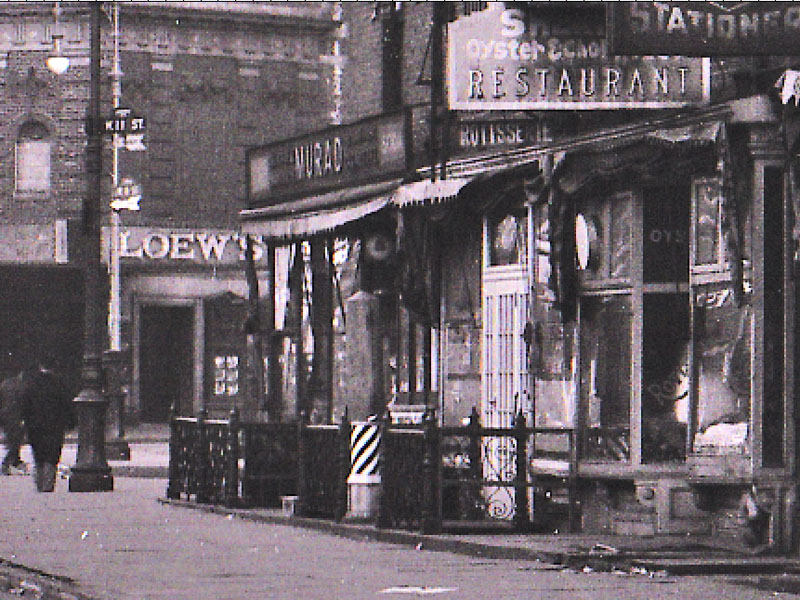
Photo bought at a New York City flea market. Click here to see the very cool, wide panorama of this 1927 scene along Greenwich Avenue that I got this picture from (then click back).In the three quotes from Gail Levin's books (see above) the Nighthawks space is described as either: For some reason, in my experience, many people have the belief that Nighthawks, was based on some 30's type chrome-plated streamlined diner like you see in the movies. Hopper never referred to the space as a diner in any of Gail Levin's quotes, though a restaurant of that size was and is still now sometimes referred to as a diner. Any small down-scale restaurunt along a Manhattan street could be called a diner. 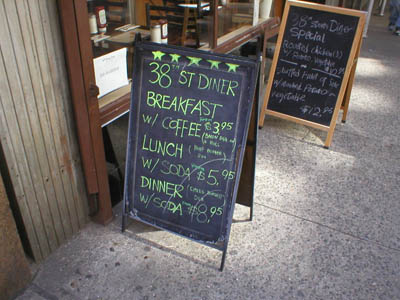
Hopper may not have called it a diner to distinguish it from the two other common forms of diner that were in New York City (and America) at that time. There were diners that resembled railroad cars - either wooden, or often plated with chrome with curved windows. And there were the hamburger chain restaurants that were usually white and resembled the White Castle restaurants of today The point is that over the years some people searching for the insspiration for "Nightawks" have looked to both of there types of restaurant as his source for the exterior of Nighthawks. But I don't think, with the exception of the curved glass windows, the the counter and the counterman, and the space's bright lighting, these were Hopper's inspirations. Here's an example of a traditional diner in Atlantic City, New Jersey. The rounded window from these type of diners may have been an inspiration to Hopper, but overall this is not similar to Nighthawks. 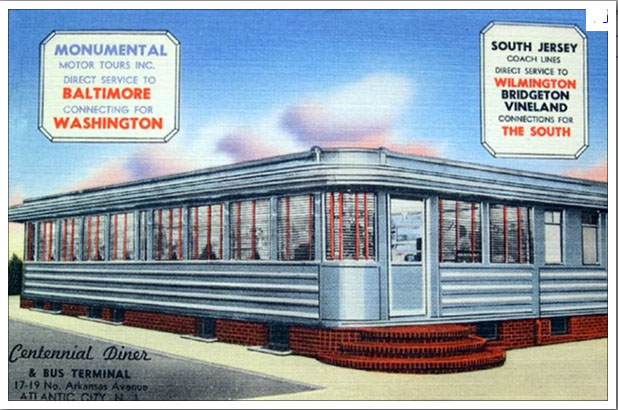
Here's another example of an older, traditional traditional "railroad-car"-like diner from 1939 on 34th Street in Manhattan 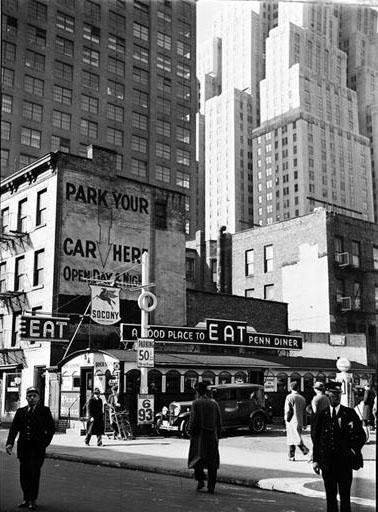
From the WPA Archives Another example of a traditional diner is in the bottom left corner of this picture. It was the "Jefferson Diner" at 6th Avenue and Greenwich Avenue. This diner, though at the bottom of Greenwich Avenue, was never mentioned by Hopper or Levin as a possible inspration. 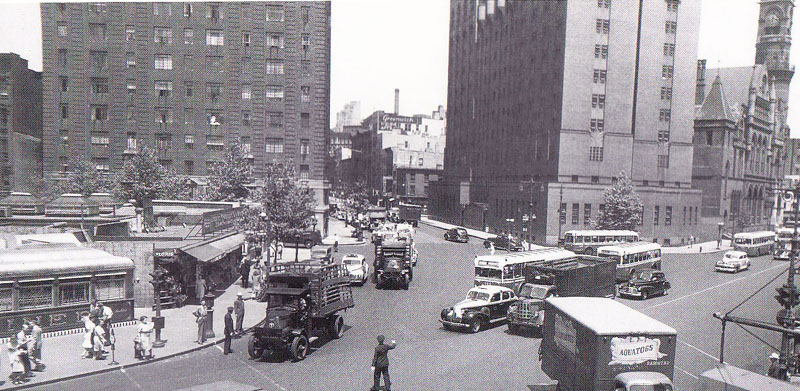
Here are some photos of the "hamburger-and-fries" type chain diner. Since the 30's they have also resembled what we recognize now as White Castle hamburger restaurants - smooth white boxes, often topped with turrets or towers with teethlike walls. These were all either on or very near Greenwich Avenue. Example of a "white box" diner - The "Castle Turret" at Seventh Avenue South and 12th Street, north/west corner (long demolished). 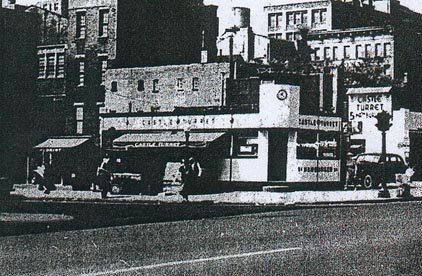
From the NYPL Digital Archives This is the same view from further back. 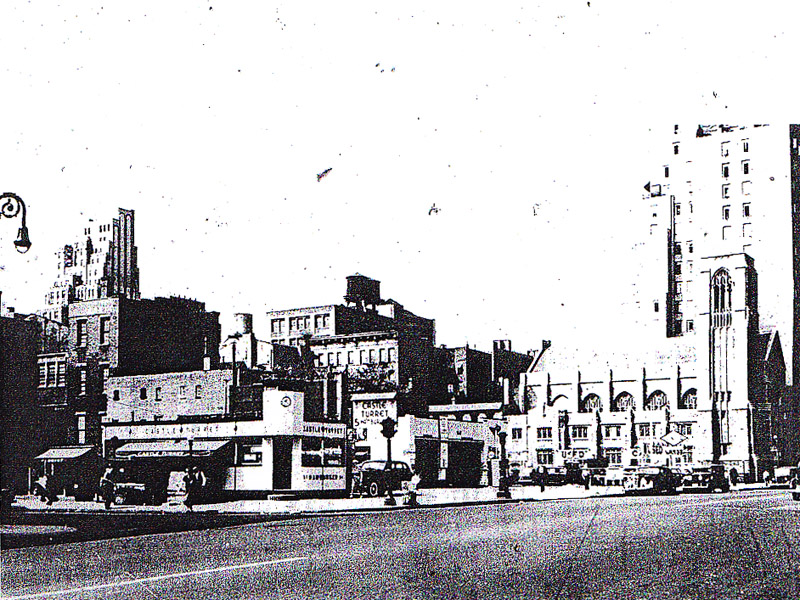
From the NYPL Digital Archives Here's another example of a "white box" chain diner - Riker's - at West 4th Street and 7th Avenue South. In shape, this could have given inspiration to Nighthawks but it wasn't on Greenwich Avenue, where Hopper said Nighthawks was based. 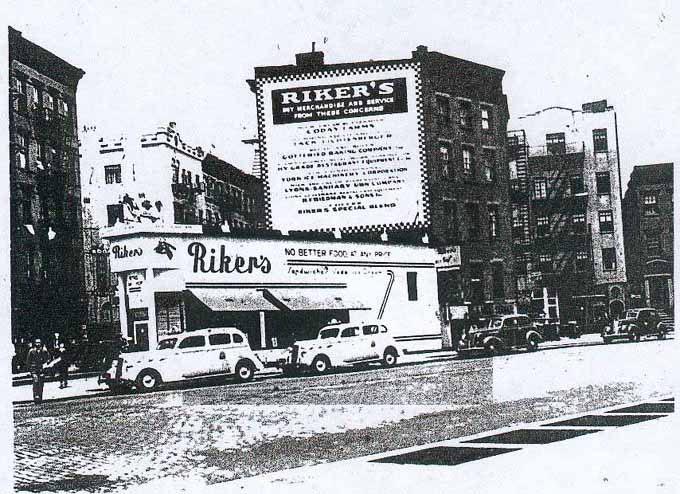
From the NYPL Digital Archives A small hamburger restaurant at West 4th Street and Sixth Avenue. 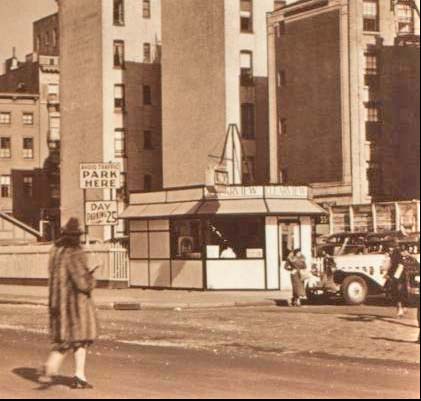
From the NYPL Digital Archives This White Tower diner was literally directly across the street from the florist shop - on Greenwich Street, west side, between 7th Avenue South and Perry. But it also doesn't resemble Nighthawks, though at night you could probably look in through the large window and see people eating under bright lights. (More on this store later) 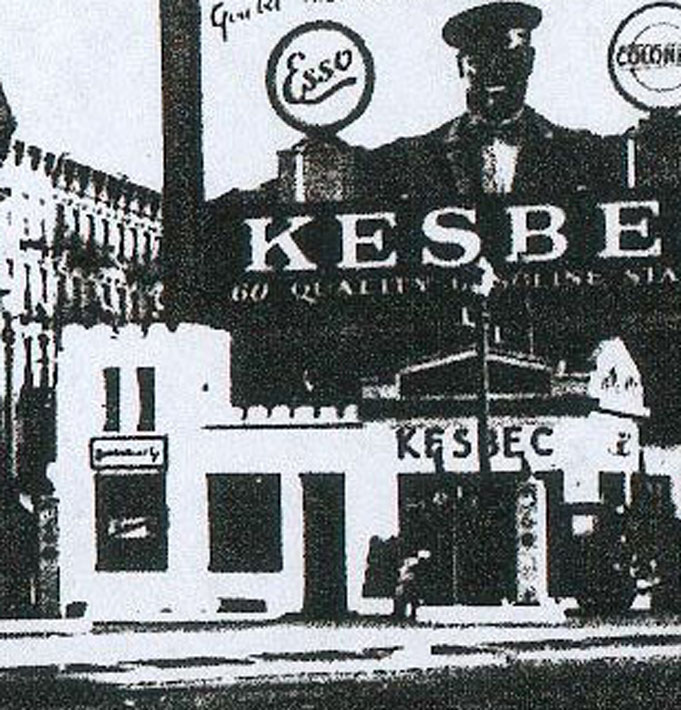
Here's the same shot from further back. The building was located on the back end of a triangular gas station parking lot between Greenwich Avenue and 7th Avenue South. 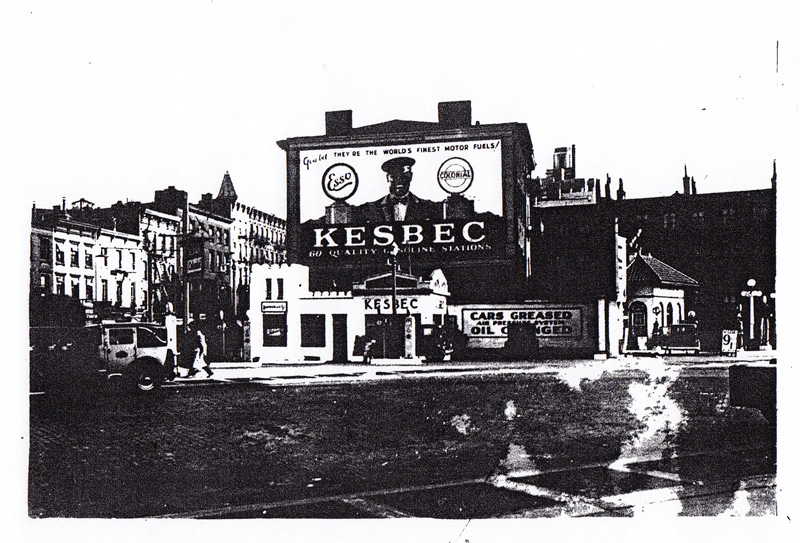
From the NYPL Digital Archives Reason #5 - Because 70 Greenwich Ave is small. The restaurant in Nighthawks is small to begin with and Hopper said he made it "bigger" than the actual restaurant. So the restaurant he based it one must have been pretty small. The "Nighthawks" restaurant has about 7 stools across the front. If Hopper increased the size of the actual restaurant he saw, then the original might only have had 4 or 5 stools. That would take up about 10 feet - They could easily fit into 70 Greenwich Avenue, which measures about 25 feet across. 
Nighthawks by Edward Hopper; collection of the Art Institute of Chicago Here's a close up of the florist store. You can see it's about 25 feet wide. To it's right is an empty store for rent. Here's a picture inside the middle of the florist shop. It's about 10 feet across at this point. (It's hard to photograph because it's so full of flowers.) 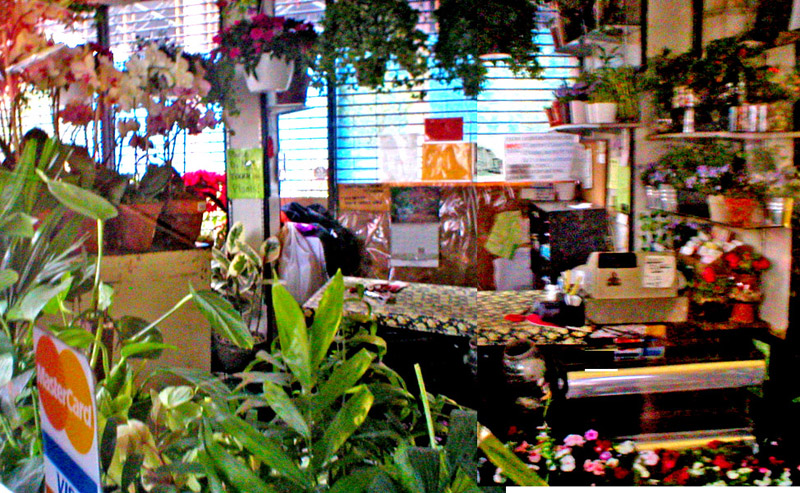
And here's a picture of the southern end. The wall is mirrored to increase the feeling of space. 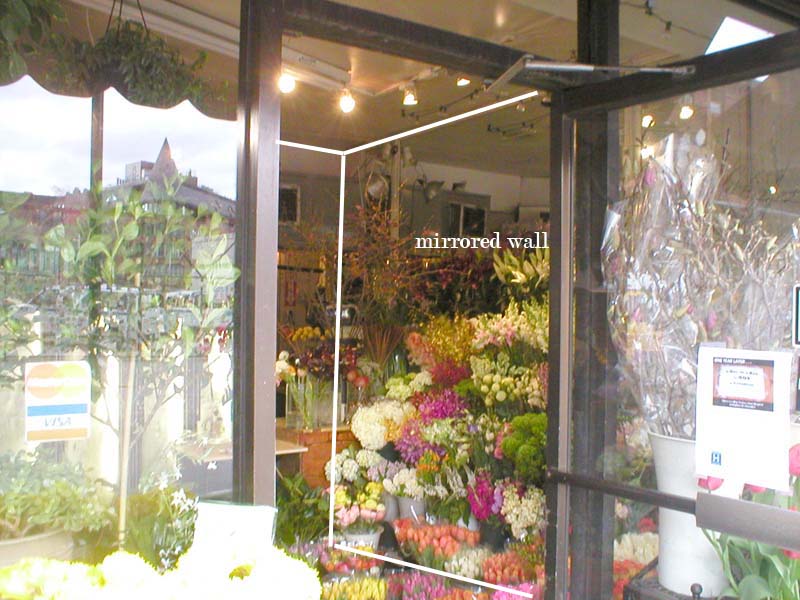
Here's a close-up of the empty store for rent next to the florist shop. The back wall is slanted like the back window in Nighthawks. This actually looks like it could fit the actual restaurant featured in Nighthawks. So if the florist shop next door was the inspiration for Nighthawks, and Hopper said he "made the restaurant bigger" - it would look this size - which it does.
Here's the space at a later date, fully stocked.
Artists often expand and contract space to make pictures work. Look at the turkey in the famous picture below by Norman Rockwell. That turkey would about 45 pounds and that grandmother's back would be snapping if that were the real size. 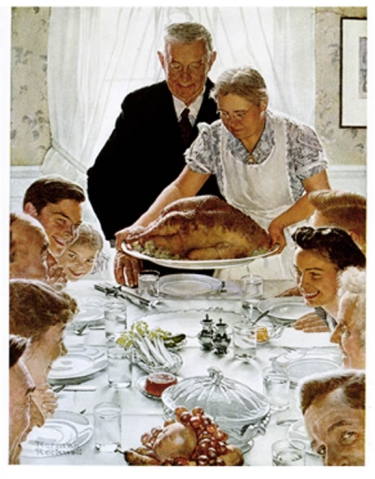
Norman Rockwell, Freedom From Want (1943), Norman Rockwell Museum Notice the difference below between a real Manhattan east-west street width and the Nighthawk's street width. The Hopper street is only one lane wide, practically a bike lane. 
Speaking of streets, I find it interesting that Hopper made the stores behind the restaurant into retail stores that resemble those in his painting "Early Sunday Morning." Mostly, because virtually all the east-west streets that Greenwich Ave crosses are residential, so, if anything, the background would most likely be in the form of apartments or brownstones. 
Nighthawks by Edward Hopper; collection of the Art Institute of Chicago These are studies that Hopper made while creating Nighthawks. In the lower one, he actually did make a small residential stoop. However, since there are (or were) similar stoops on practically every street off of Greenwich Avenue, it doesn't really help pinpoint the corner. 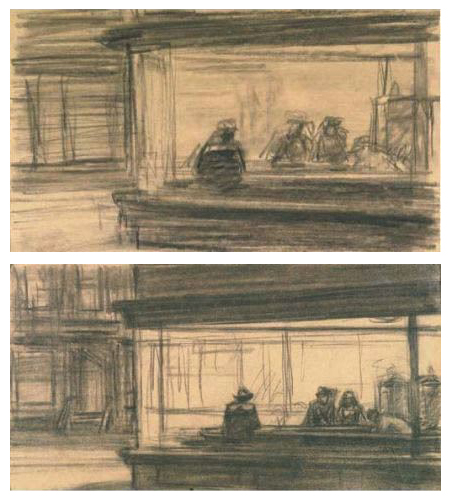
From the collection of and (c) the Whitney Museum If 70 Greenwich is indeed the space Hopper used for Nighthawks, he may have conjured up his own background because he did not think that the background presently that was there would be "right" for the painting. The background at that time would have been this hospital (now demolished) on the northeast corner of 11th Street and 7th Avenue. 70 Greenwich Avenue (the florist shop) is on the bottom, right. 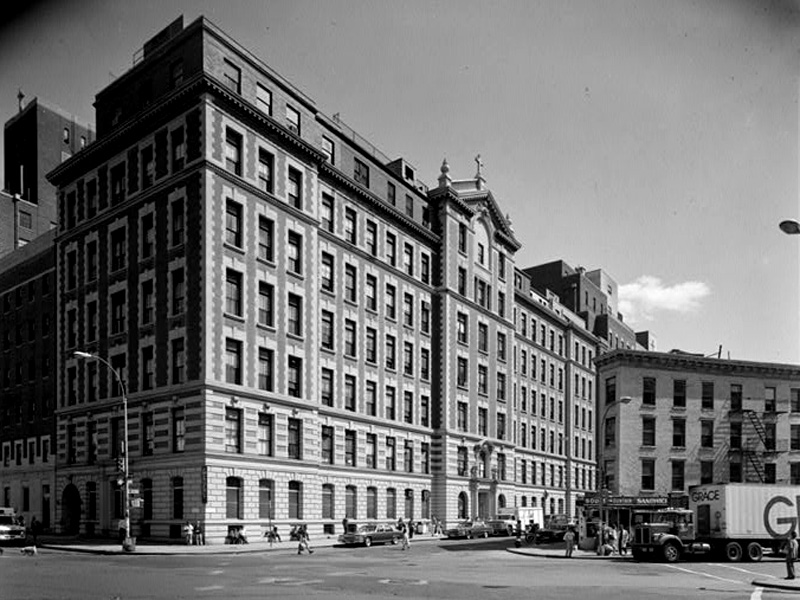
There is one thing that I noticed in one of the windows above the stores, however, that I've never read about before: a cat! Is he hungrily and metaphorically gazing down at the "hawks" as prey? You can find him in the second window from the left in the painting two pictures below this. 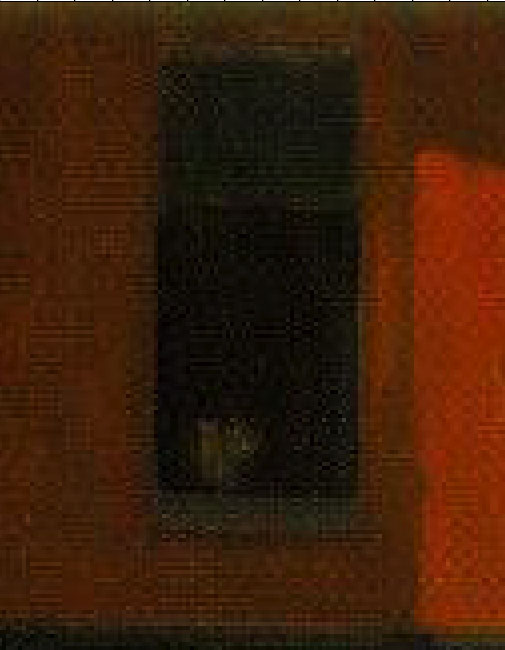
Here's a similar cat I found on Flickr, to illustrate my point." .jpg)
From Flickr Reason #6- Because Hopper painted a cigar sign above the restaurant and not the name of a restauant. 
Nighthawks by Edward Hopper; collection of the Art Institute of Chicago Most restaurants don't have huge cigar signs over them. They usually have have the name of the restaurant prominantly displayed. But small, fountain-type store/restaurants don't need to name themselves. But they need to show what they sell. As you've seen from the many earlier pictures of the store at 70 Greenwich Avenue, the space has had a long tradition of advertising cigars, because as a combination fountain restaurant and cigar/candy store, they long sold cigars. So the fact that Hopper put a huge Phillies sign over the Nighthawks restaurant further supports that this was his probable inspiration, not another real-named restaurant somewhere along the block. Hopper's Phillies sign was pretty authentic. Here are some other Phillies' signs of the day and also one for a Cremo cigar that looks like the Nighthawks sign. 
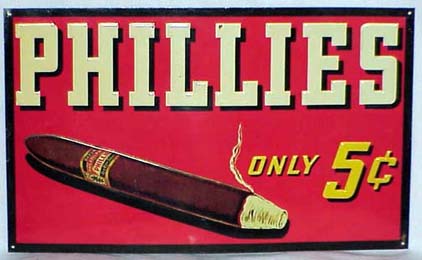
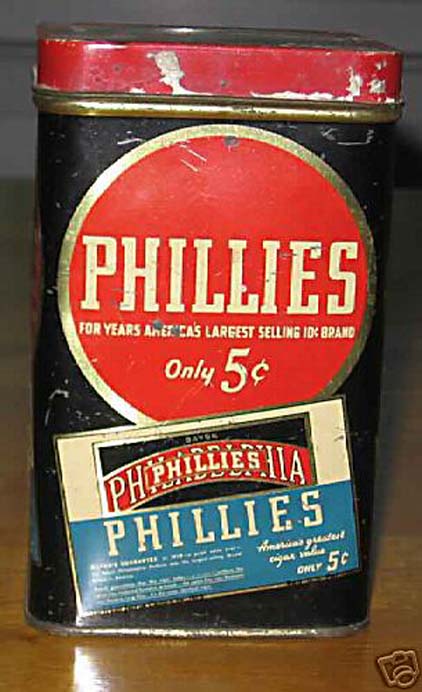

Reason #7 - Because the interior of the restaurant is in the shape of a triangle. Most restaurants are rectangular. The real 70 Greenwich Avenue is a triangular space. This also lends creedence to the theory that when Hopper described it as a place on Greenwich where "two streets meet." They meet at a triangle. If you look at Nighthawks closely, you can see there's not a door for the fountain man to get behind the counter. How does he get inside? Is he proverbiably trapped in there forever? Or is it a sly reference to the existantial "no exit?" 
Nighthawks by Edward Hopper; collection of Art Institute of Chicago Reason #8 - Because both have a similar interior support pole behind the glass. Because both the Nighthawks restaurant and the space at 70 Greenwich are "prows," they need roof support. The metal beam holding up the roof is clearly seen in both images. You would most likly not find these beams if the space was a one-story restaurant, as the supporting beams would be part of the brick/steel structure. 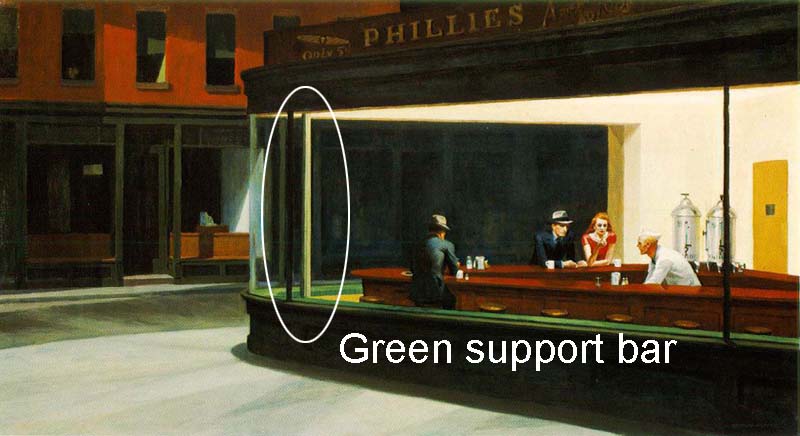
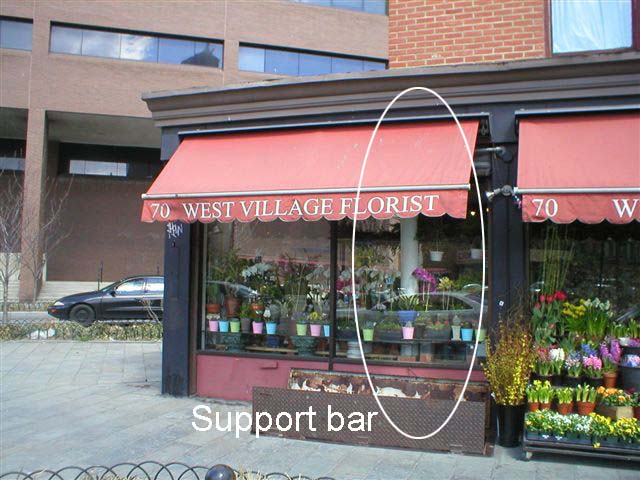
Reason #9 - Because the White Tower hamburger restaurant across the street could have given Hopper ideas about the lighting, the counter, the salt and pepper and sugar shakers, the stools, the bent-over fountainman and his cap, and even "the man with his back to us." This is an actual photo from the White Tower restaurant that used to be on Greenwich Avenue on the south part of the gas station lot that took up the corner of Greenwich Avenue and Seventh Avenue South. It is courtesy of the owner of the former White Tower hamburger chain, T. Brock Saxe, who sent it to me at my request in 2006 along with a few more photographs, seen below. The restaurant was called White Tower #2, as it was the second one built in the chain. 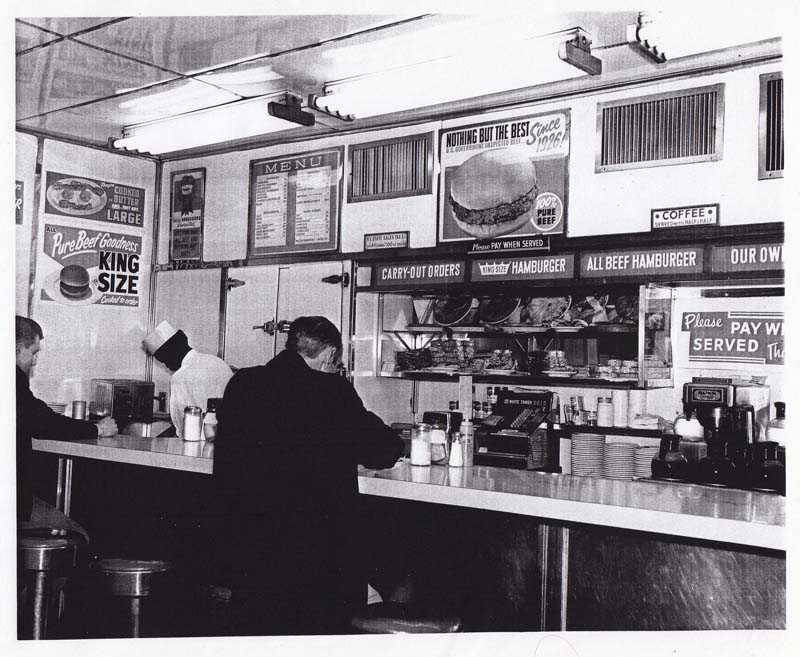
Courtesy of T. Brock Saxe Note the many similarities to the interior of Nighthawks.
.....the man with his back to us. The picture we just looked at is circa the mid-1950's. I showed it first because it has more activity in it. The picture below this is from the 1940's - Hopper's era. The florescent lighting is different, but most of the rest is the same. But note the counter. Unlike the Formica counter from the 1950's, this counter is made of dark wood very much like like the counter in Nighthawks. 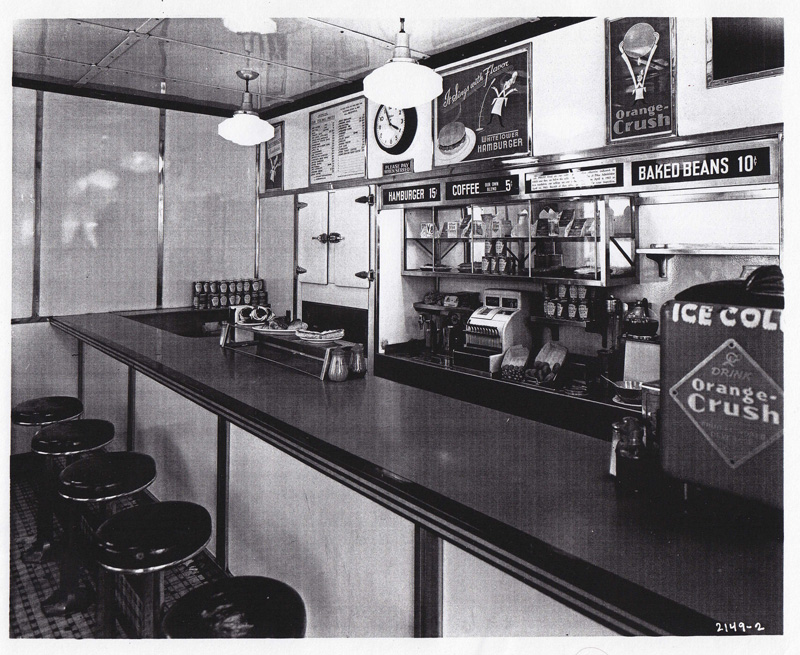
Courtesy of T. Brock Saxe Hopper could have literally sat on one of these stools and looked out the window to his left and seen what is now the florist shop across the street and sketch it as he drank coffee. Here is where it was located in relation to the florist shop. 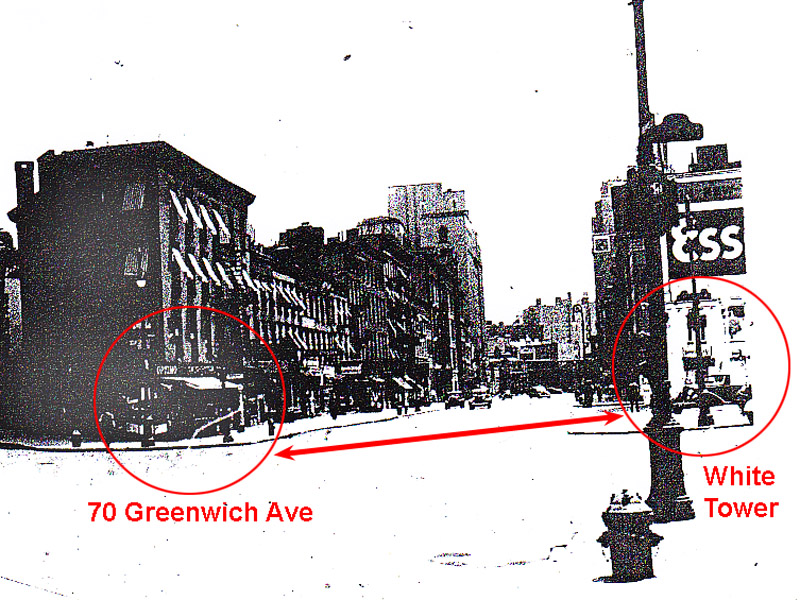
In fact, here's a panorama of what Hopper would have seen had he looked out the window. The florist shop is circled in red. CLICK THE PHOTO TO ENLARGE IT 
This is another photo of the White Tower #2 restaurant at Greenwich Avenue and 7th Avenue South from the New York Public Library, so you can see where it was located. 
And here's another photo of White Tower #2 sent to me by Mr. Saxe. 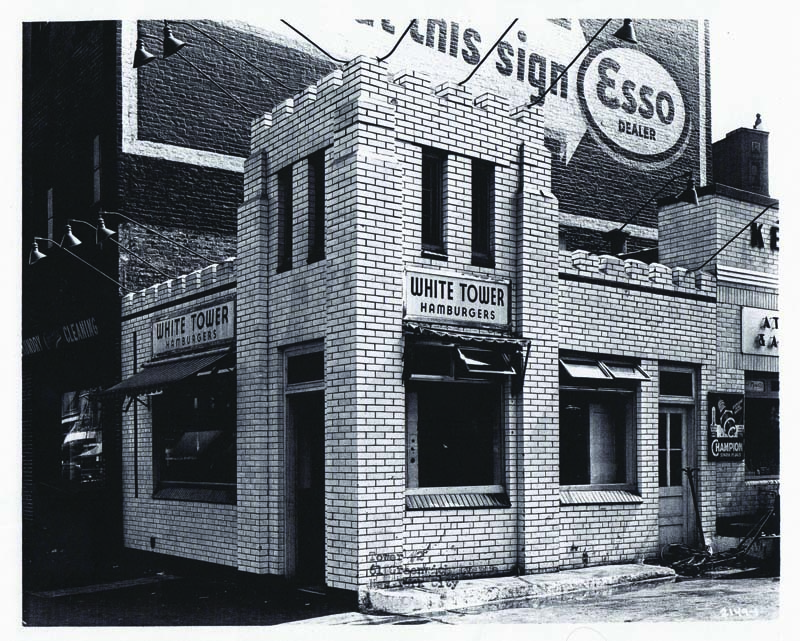
Courtesy of T. Brock Saxe When I began researching Nighthawks in 2005, I had read in many guidebooks that the painting was based on a "diner" that was in the parking lot at Greenwich Avenue and 7th Avenue South, below the intersection called Mulry Square. This turned out to be a guess turned into a fact by heresay. Sanborn Maps and Bromley Maps (NYC tax and city planning maps with outlines of buildings and numbers indicating how many floors they have) from back as far as 1938 never showed a diner (or any other structure) in the tip of the parking lot, but a search of the NYC Municipal Archives, using the block-and-lot of the corner, turned up the White Tower building. So I tracked down the ownership by looking through old books about chain diners and sent Mr. Saxe a request for these photos which he graciously provided. I quickly concluded, however, that the exterior of Nighthawks didn't look like this diner, so I continued my search up and down the avenue for Hopper's inspiration. My three kids had gone to school at P.S. 41 at the other end of the block from the florist shop, and I had always told them that I thought Hopper had based it on the florist shop space, simply by it's wedged appearance and see-through glass sides. But I had to eliminate all the other possibilities up and down the Avenue before I could, with some evidence, point to it as the most possible inspiration, and that search, done sporadically, took a backseat for a while to the other searches on PopSpots. That's why it took me so long to put this together. Mr. Saxe also provided me this photos of White Tower #2 in the 1950's, when it had been remodeled. Here it is: 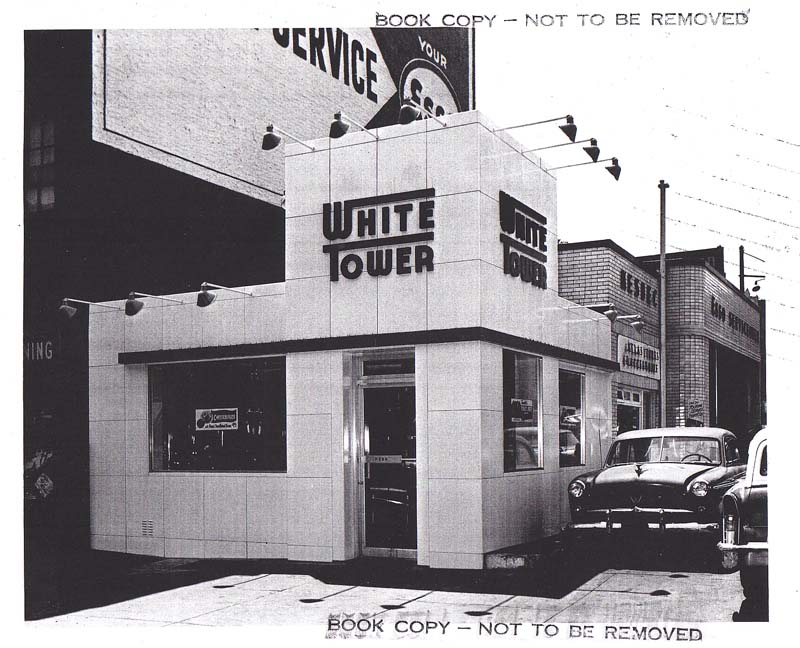
Courtesy of T. Brock Saxe Quick comedy relief: an old ad for a fountain "jerk" in the outfit of the day. 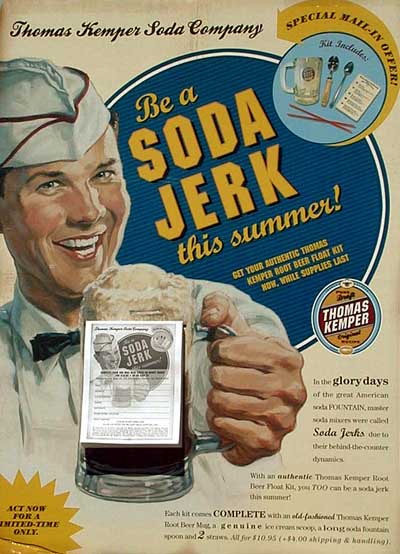
The White Tower building closed and fell into disrepair in the 1970's as you can see from this photo. 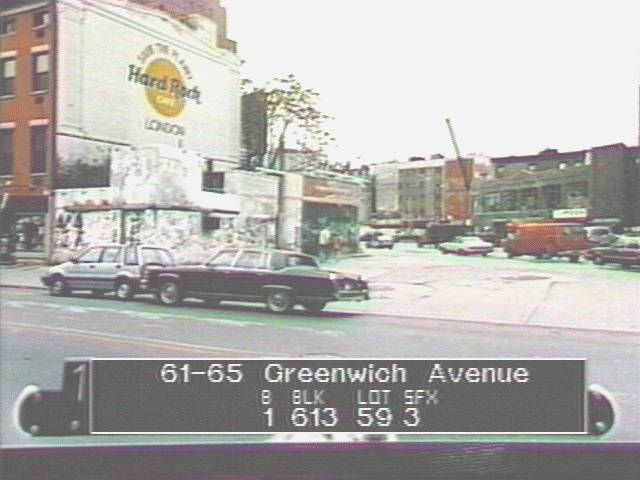
Later it was demolished. Conclusion: Nighthwaks was definitely based on one particular restaurant on Greenwich Avenue. Hopper said it himself when he said that he "made the restaurant bigger." What I tried to do, was show by reason of elimination, that the logical ONE restaurant was most likely the one at 70 Greenwich Avenue, because: 1) It's extreme, approximately 30-degree "v" shape resembles that of Nighthawks. Only 4 other prime candidates have close to that extreme angle. But they don't have the other characteristics. No other space on Greenwich Avenue has all these characteristics. So, although there are also many characteristics of the Flatiron Building in the painting, since Hopper said he based it on a building on Greenwich Avenue, I would say 70 Greenwich Avenue fits the bill best. Let me add this. I put forth four other spaces with extreme "v" angles that Hopper could have based the painting on. Each could easily have been a restaurant. And he may have based 99% of the painting on one of them. But in the end, the one main characteristic of the painting is that Hopper set it in a long prow, so, to me, that characteristic trumps all the rest. So if you gotta pick one restaurant, that he probably based it on - because Hopper indicated by his quotes that there was one restaurant in particular - I will go with 70 Greenwich Avenue. So go down and buy some flowers and see for yourself! THE INTERIOR of "Nighthawks While my primary aim was to discuss the location of Nighthawks, along the way I came up with some interesting information about the interior. Here it is. Quotes relating to THE INTERIOR OF NIGHTHAWKS 1) "To get the(coffee) urns he went to the Dixie Kitchen, a coffeeshop where he and Jo often picked up a cheap meal." Gail Levin, Edward Hopper: An Intimate Biography Knopf, 1995, New York paperback, page 349. footnoted to Jo Hopper diary excerpt for March 24th, 1959. A Google search for the "Dixie Kitchen": yielded this abstract from a collection of 1970's "The New Yorker" articles. It mentions Hopper as a frequent visit to a "Dixie Kitchen" in the basement of a building at Fifth Avenue and 48th Street I underlined those lines). :
"Talk story about the Dixie Kitchen, which closed down the other day. It was a cafeteria in the basement of an office building on the northeast corner of 5th and 48th Street. It lasted 46 years serving excellent food at reasonable prices. Its two proprietors were: Mrs. Margaret Deane & Miss Ethel Dilman. The bill of fare featured real American home cooking, with an emphasis on real Southern home cooking. The Dixie Kitchen never advertised except in the "Christian Science Monitor." Mrs. Deane grew up in Virginia & attended Randolf-Macon Woman's College in Lynchburg. Miss Dilman is from Finger Lakes country, north of Ithaca; she's a Vassar graduate. The best-known work of art in the Dixie Kitchen was a signed reproduction of Edward Hopper's painting of an all-night lunch counter. Mr Hopper frequented the Dixie Kitchen. Mrs' Dean's husband often helped out with the bookkeeping. Roses were brought in by a black counterman named Bert North, who lived in New Rochelle and raised flowers. Last month Mrs. Dean and Miss Dilman decided that it was time for them to retire." (Anthony Hiss, The Talk of the Town, "Farewell," The New Yorker, January 3, 1970, p.22) Image of a typical restaurant coffee urn popular in the 1930's to 1950's. 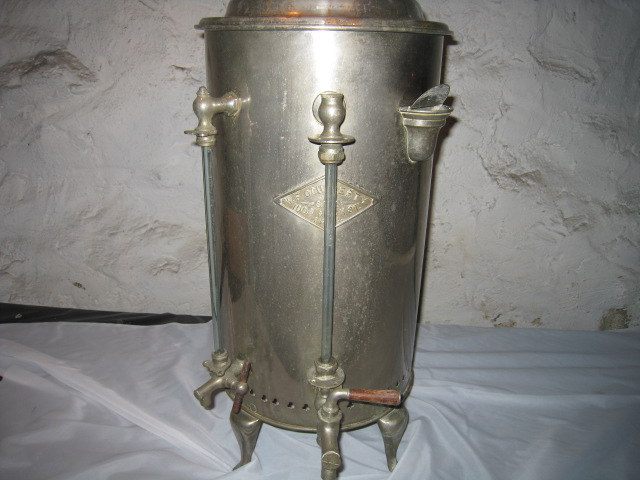
Hopper's Studies for the coffee urns from 1943 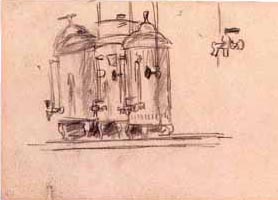
From the collection of and (c) the Whitney Museum The Dixie Kitchen would have been in the basement of this corner building at the northeast corner of 48th Street and Fifth Avenue. 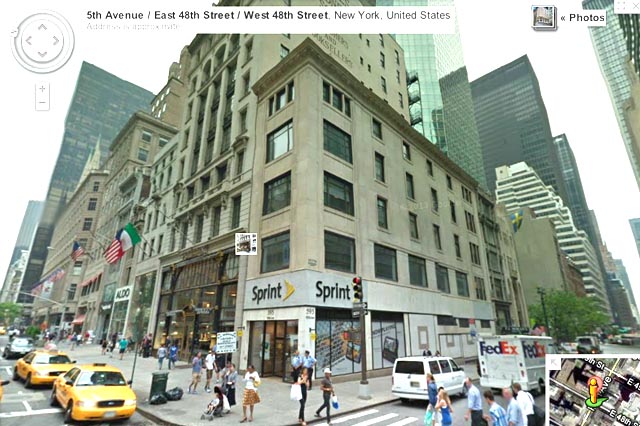
From Google Street Views 2) "Hopper may also have found one of the illustrations for the "The Killers" suggestive. C. Leroy Baldridge depicted a counterman by a coffee urn that is almost a mirror image of the detail in Nighthawks. Hopper must have seen both the story and the illustrations a second time after Scribner's reprinted them along with one of his own illustrations in its 50th Annivesary issue of January 19337, 101, pp.83 and 73." -Gail Levin, Edward Hopper: An Intimate Biography Knopf, 1995, New York paperback, page 616 in footnote #9.. 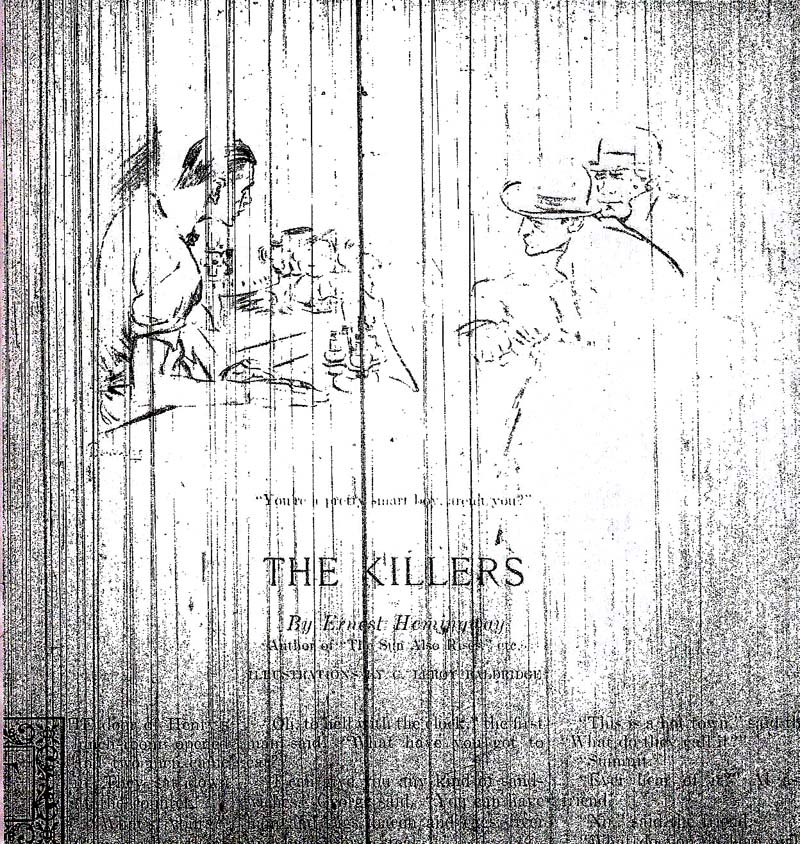
Image of a coffee urn from "The Killers" - a short story by Ernst Hemingway in Scribner's magazine. The urn can be seen under the face of the man at the left in this xerox from a microfilm at the library. Quotes on THE THEME AND MOOD OF NIGHTHAWKS 1) He (Edward Hopper) "drew on sources" such as popular "gangster movies popular in the 30's; and Ernest Hemingway's "The Killers," a story Hopper liked so much upon reading it in Scribner's for March 1927 that he wrote to the editor..." Gail Levin, Edward Hopper: An Intimate Biography Knopf, 1995, New York paperback, page 350. This is the beginning of the short story, "The Killers" by Ernest Hemingway that starts with two tough looking characters walking in to a diner." 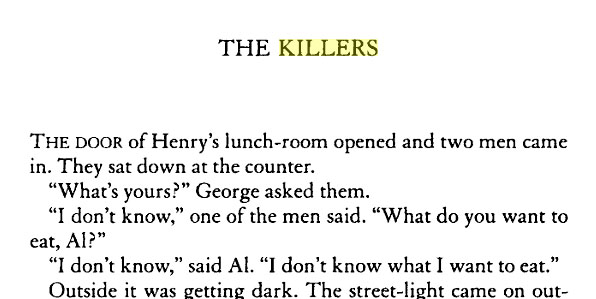
Here are the opening scenes from the 1946 movie "The Killers" (Universal Pictures). Note the resemblance in mood to Nighthawks painted 4 years earlier. Hopper was influenced by Hemingway's short story. and the director of the film was later influenced by Nighthawks.
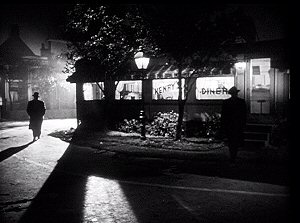
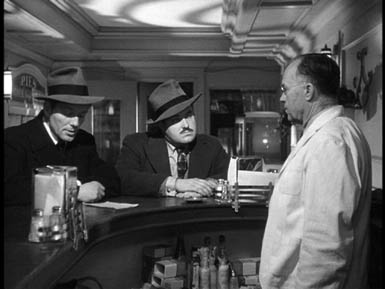
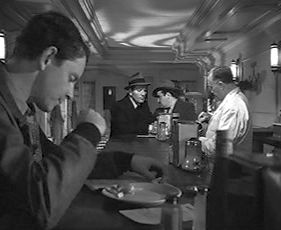
The actual diner where they filmed the scene is in Summit, New Jersey. 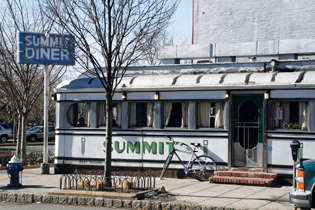
Notice the resemblance, especially with the man at left with the fedora. 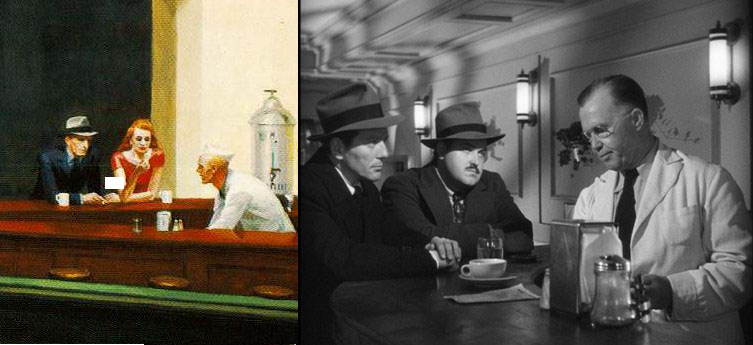
That's the entry. Thanks for stopping by the PopSpots all-night online cafe. 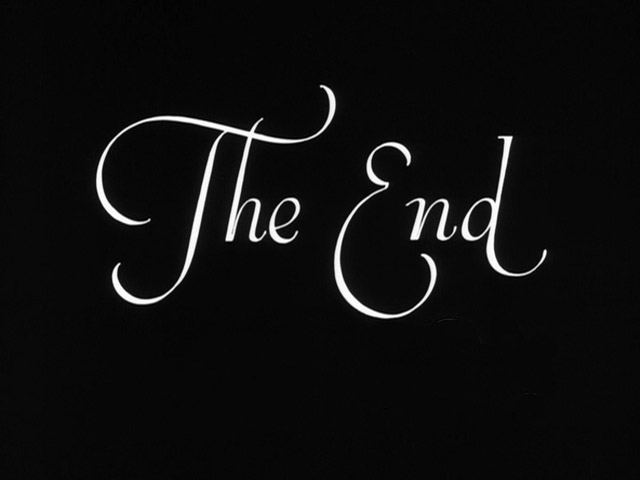
|
||

